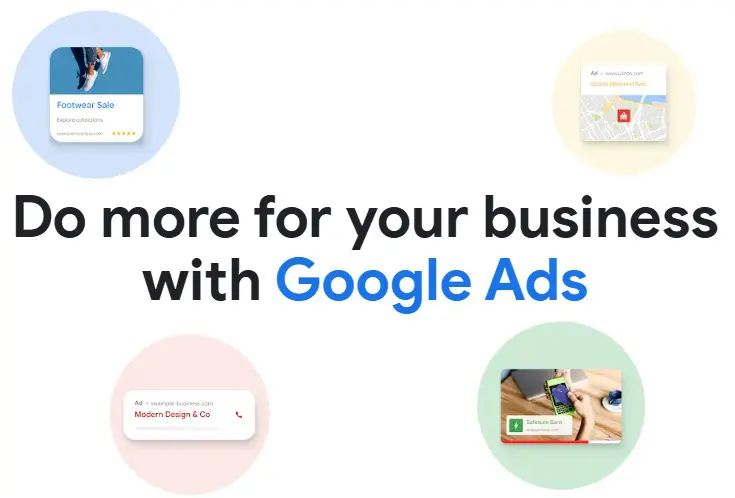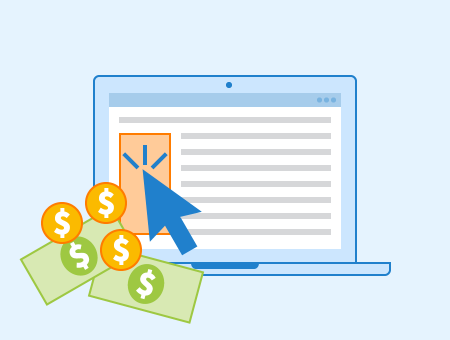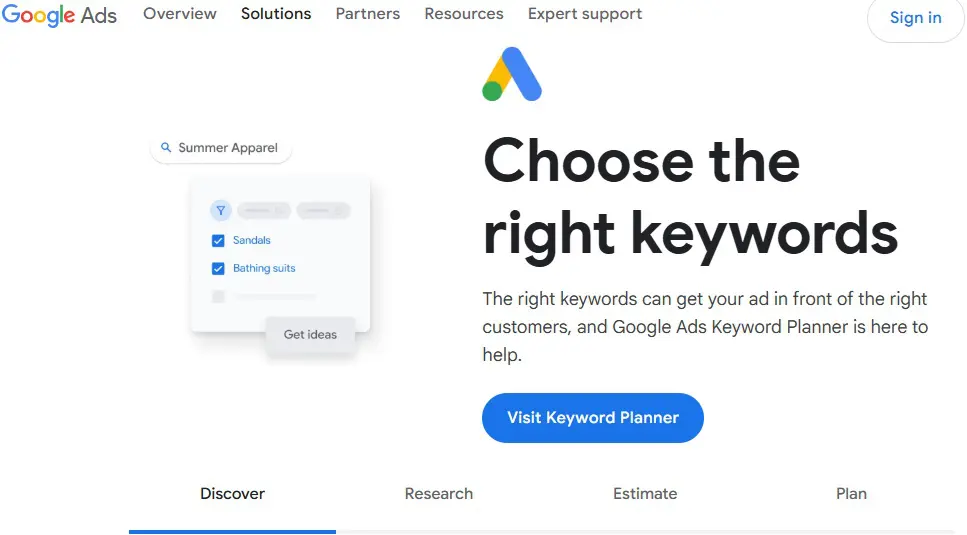Google Ads is a tool that can put your business in front of customers who are searching for what you offer. By far the world’s leading Pay-Per-Click (PPC) platform, it lets you run campaigns, track how they’re performing, and shake things up as needed.
And it’s easier than you might think, even for the non-technically-minded small business owner! With a well-targeted campaign and the right keywords, you can get your brand out there — no need to call that advertising agency.
What is Google Ads?
Since its launch in 2000 (as Google AdWords), Google Ads has grown into the internet’s biggest Search Engine Marketing (SEM) tool. More than a million businesses worldwide are using it today.
‘Ads operates on a Pay-Per-Click (PPC) model. That means you only pay when someone clicks on your ad. No clicks, no charge. So while it isn’t free, it can be a very cost-effective way to put your business out there in front of potential customers.
The beauty is that it lets you reach people who are already searching for what it is you do or offer — be that a baker in Bristol, a hairdresser in Harrogate, a florist in… you get the picture.

One advantage of online ads is that they’re much more targeted and measurable than traditional ones: unlike with billboards or magazines, where you pay regardless of whether anyone notices, Google Ads lets you set your own budget and track performance, so you know exactly where the money’s going.
Google claims that for every $1 spent on Google Ads there’s a return of $8. While that’s based on an average across all industries, it can certainly do a lot for smaller businesses, too.
More than half of small-to-medium-sized businesses (SMBs) run PPC campaigns today. For reference, the average conversion rate for Google Ads on the search network is about 4.4%.
Mobile users are often more responsive to paid ads, especially for local searches — another reason your website needs to look great and load fast on phones.

SERP – Author: Seobility – License: CC BY-SA 4.0
What’s the difference between SEO and SEM?
Search Engine Optimisation (SEO) is all about helping your website show up higher in search results “organically” — or without paying for ads. It’s about using the right keywords, good links, and quality content. It can take time, but it pays off in the long run.
Search Engine Marketing (SEM) is about using paid ads to get seen straight away. It includes things like display and remarketing campaigns — all ways to get your business noticed fast. Those ads you spot on Google Search are SEM.
In short:
☐ SEO = Improving your site’s organic (unpaid) ranking through good quality content and smart website tactics. Slow, long-term results.
☐ SEM = Paying for ads to show in search results. Fast results, but only while you’re paying.
Google Ads don’t just show in search — they can also pop up on websites and apps like YouTube, helping your business reach people wherever they are.
For more: Local SEO in 10 – How Do I Get My Business Found Online?
How to get started with Google Ads
Let’s walk through the steps to set up your campaign and start getting your business noticed.
Before we get into it, we’ll assume you’ve already built a site using a great tool like Website Builder or Managed WordPress. Be sure to create a Google Business Profile so you can get found on maps, also.
Add Google Ads into the mix, and you’ll have all the right tools to show up exactly where your potential customers are looking.
1. Sign up and set up your Google Ads account
First, head to the Google Ads home and sign up.
You’ll need to enter your business name and website URL. If you already use other Google tools, like Google Analytics, linking them will make setup quicker.

Once you’ve signed up, you’ll land on the main Google Ads dashboard. Don’t worry—it’s simple to navigate. This is where you’ll create your campaigns and keep an eye on how they’re doing.
If this is your first time, Google will set you up in Smart Mode by default. It’s a simpler setup that helps you get started quickly, but limits some of the advanced options.
You can switch to Expert Mode at any time for more control over your campaigns and targeting.
2. Choose your campaign goal
Next up: pick your campaign goal. This is the big picture—what do you want your Google Ads to achieve? Choosing the right goal helps Google show your ads to the people most likely to respond.
Google Ads offers several options depending on what you want to achieve. Here’s a look at your options:
☐ Drive website clicks – More clicks, more eyes on your business.
☐ Generate leads – If you’re after sign-ups, form submissions, or customer inquiries, this is the one.
☐ Boost sales – Set this goal to focus on increasing purchases or conversions on your site.
3. Set your budget and bidding
Before your ads start running, you’ll need to set your budget and get to grips with “bidding”.
Think of it like an auction for clicks: every time someone clicks your ad, you pay a bit. Bidding is just the fancy word for how much you’re willing to pay per click.
Decide whether a daily or monthly budget works best for you. If you’re new to this, start small and increase gradually as you see what’s working.
When it comes to bidding, there are two main ways of going about it:
☐ Manual bidding – Setting the maximum amount you’re willing to pay per click for full control.
☐ Automated bidding – This lets Google optimise your bids to get the best results within your budget.
4. Start creating your ads
Now it’s time to make your ads! Google Ads gives you several ways to get noticed, depending on how you want to reach potential customers.

Choose your ad format
☐ Search Ads – These show up at the top of Google as “Sponsored” results when someone searches for something related to your business. Perfect for reaching people who are ready to buy. They usually just have a headline and description—no images needed.
☐ Display Ads – These include images and pop up across websites, apps, and YouTube. They’re aimed at people based on interests, even if they’re not actively searching for what you offer.
☐ Shopping Ads – Great for eCommerce. Show product images, prices, and details directly in Google search results.
☐ Native Ads – These blend into the content of Google’s partner websites. Users click through naturally, and you pay when they engage.
Don’t worry if this feels like a lot—Google will often recommend the ad type that works best for your campaign goal.
Performance Max: Let AI do the work
Finally, there’s Performance Max (or PMax). This isn’t a separate ad type — it’s an AI-powered campaign that runs across all Google channels, including Search, Display, YouTube, Gmail, and Maps.
Performance Max automatically tests different combinations of headlines, images, and videos to see what works best. The idea is for AI to get you more clicks, leads, or sales from your budget, without you having to do all the trial and error yourself.
5. Create your headlines and descriptions
Now, it’s time to get creative. This means writing headlines that grab attention, plus descriptions that explain what you offer.
For example, “Fast Plumbing Services in London” or “Free Delivery on All Orders.”
In the description, you can offer more detail and include a clear call-to-action (CTA), like “Book Now” or “Find Out More.”
The exact number of headlines and descriptions, as well as their character count, will depend on the type of campaign you’ve gone for. Keep it short and focus on what makes your product or service special.
For Search Ads, you can include up to 15 headlines (30 characters each) and 4 descriptions (90 characters each). Google will automatically test different combinations to see which ones perform best.
Tip: Don’t forget to add ad extensions — now called “assets” — such as call buttons, sitelinks, or location info. These make your ads more useful and eye-catching, and they often increase click-through rates.
Choose the right keywords for your campaign
Keywords are the words or phrases people type into Google when looking for something. Choosing the right ones helps your ads show up for the right audience.
Google Keyword Planner is a free tool that helps you discover keywords related to your business, which you can find in your Google Ads dashboard under Tools. It shows helpful info like search volume, competition, and an estimated cost-per-click for each keyword.
This step’s optional, but taking a little time to pick the best keywords can really improve how your ads perform.
Enter a few ideas into Keyword Planner, and Google will suggest related terms. Try to focus on long-tail keywords — these are more specific phrases (like “dog-friendly hotel in Devon” or “affordable yoga classes in Oxford”).
Long-tail keywords usually have less competition and tend to attract people who are ready to buy or take action. Using them in your ad headlines and descriptions can make your ads more relevant and successful.
6. Set your match type
Match types decide how closely a search term needs to match your keyword for your ad to show.
When you’ve chosen your keywords, you’ll need to pick a match type:
☐ Broad match reaches more people but with less control. Your ad could show for searches like “florist in Bristol” or “flower shop in Bristol.”
☐ Phrase match is more specific. Your ad will show for searches that include your exact phrase, like “best florist in Bristol” or “florist in Bristol open now.”
☐ Exact match is the most restrictive but gives you the most control. Your ad will show only for exact phrases, like “florist in Bristol.”
☐ Negative keywords stop your ad from showing for certain searches. For example, if you sell high-end flowers, you might exclude “cheap florist in Bristol.”
Picking the right mix helps your ads reach the best audience.
7. Choose your target
Target specific locations to be sure you’re reaching the right audience. If you run a local business, focus on your city, region, or even specific postcodes. This way, you’re only showing your ads to those who are most likely to need your services.
☐ Location targeting: If you run a local business, focus on specific areas like your city, region, or even postcodes. This ensures you’re only showing your ads to people who are most likely to need your services.
☐ Demographic targeting: You can also narrow down your audience by age, gender, or even interests. Personalised ads can make a big impact, perhaps increasing sales by as much as 30%.
☐ Retargeting: Show ads to people who’ve already visited your website but didn’t take action. By reminding them of your offer, you can increase the chances of converting them into customers.
8. Review, and launch!
Nearly there. Give everything a final check — budget, audience, headlines, descriptions. Once everything looks good, add your payment details and hit Launch.
Your ad is now out there, working its magic, and hopefully reaching the right people at the right time. Keep an eye on performance and wait for the results to roll in.

Author: Seobility – License: CC BY-SA 4.0
Remember: You can tweak most things even after your campaign is live—like your budget, bids, keywords, and targeting. If something isn’t working, try adjusting your ad copy or testing new headlines. You can also pause or change specific ads.
Tips to make Google Ads work for your business
✓ Start small with your budget: Test your campaigns with a small budget, and as you identify what’s working, gradually increase your spend. This helps minimise risk and allows for optimisation as you go.
✓ Use location-based targeting: If you run a local business, target customers within a specific region. For example, instead of just targeting “personal trainer,” try “HIIT personal trainer in Oxford”. This will help you attract the relevant audience.
✓ Make use of ad extensions: Add extra details directly in your ad, such as your address, phone number, or opening hours. This makes it easier for customers to contact you directly.
Also, don’t forget about Google Trends. It’s especially handy for spotting seasonal trends or finding new keyword ideas before your competitors do.
See also: How to Use Google Trends for Your Online Business
How to measure ad success
Once your ads are live, you’ll want to track their performance to understand what’s working and what needs tweaking. Focus on metrics like:
☐ Click-through rate (CTR) — How many people click your ad after seeing it. A high CTR should mean your ad is relevant and engaging.
☐ Conversions — How many clicks turn into actions, like purchases or sign-ups. The higher the conversion rate, the more effective your ad and landing page are.
☐ Return on ad spend (ROAS) — Checks if your ads are making money. For example, if you spend £50 on ads and make 200 quid in sales… that’s a strong ROAS!
Small changes can make a big difference. Keep an eye on the numbers, test what works best, and fine-tune things over time.
More ads tips
Make sure your landing page works for your ads
A good landing page can turn clicks into customers. If your ad promises a specific product, offer, or discount, make sure the page delivers exactly that.
On the other hand, pages that are cluttered or slow will drive visitors away, and even more so on mobile. A fast, easy-to-navigate page keeps customers engaged and ready to buy.
Need a landing page without the hassle? 123 Reg Website Builder makes it simple to create professional, mobile-friendly pages that load fast and fit your Google Ads perfectly — no tech skills needed!
Find that winning formula: PPC + Content Marketing
Running a blog, sharing posts, or sending newsletters helps customers get to know your business. This is good for your brand and gets you found on search engines, but it takes time to see results.
The best approach? Use both. Run Google Ads to attract immediate traffic while growing your audience through blogs, social media, and other organic marketing. It’s the best way to show up wherever customers are looking.
See also: Top 8 Social Media Management Tools and How to Find Fantastic Content for Your Social Media Feeds
Wrap Up
Google Ads can be a powerful way to get your business noticed. By showing your ads to people who are already searching for what you offer and using the right keywords and targeting, you can start seeing real results.
For some more official resources, check out:
Google Ads Help Center – With step-by-step guides and answers.
Google Skillshop – For free courses to get Google Ads savvy.






